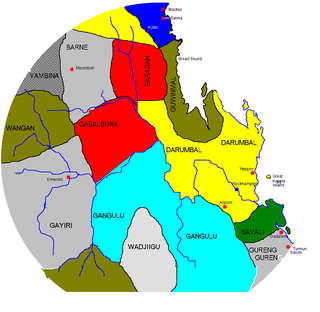Social organization
In 1900, R. H. Mathews, a surveyor and self-taught anthropologist, presented a paper attributing to the Mariu — together with other "large and important tribes", from both Western Australia and the Northern Territory, such as the Gija, Perrakee, Gooniyandi, Nyigina, Bunuba, Djaru and Walmadjari — an 8 section marriage system among clans, which he illustrated in the following general table.
| Phratry | Father | Mother | Son | Daughter |
|---|
| A | Jungurra | Nungulla | Jabulgie | Nabijerry |
| Jackara | Nabijerry | Julimar | Naboron |
| Janima | Naboron | Jungary | Nabungarty |
| Jambidgena | Nabungarty | Jangula | Nungulla |
| B | Jangula | Nangilee | Jambidgena | Nambidgena |
| Jungary | Nambidgena | Janima | Nabina |
| Julimar | Nabanna | Jackara | Nackara |
| Jabulgie | Nackara | Jungurra | Nangilee |
|
The Gidabal, also known as Kitabal and Githabul, are an indigenous Australian tribe of southern Queensland, who inhabited an area in south-east Queensland and north-east New South Wales, now within the Southern Downs, Tenterfield and Kyogle Local Government regions.

The Gangulu people, also written Kangulu, Kaangooloo, Ghungalu and other variations, are an Aboriginal Australian people from the Mount Morgan area in Queensland, Australia.
The Waanyi people, also spelt Wanyi, Wanji, or Waanji, are an Aboriginal Australian people from south of the Gulf of Carpentaria in Queensland and the Northern Territory.
The Garrwa people, also spelt Karawa and Garawa, are an Aboriginal Australian people living in the Northern Territory, whose traditional lands extended from east of the McArthur River at Borroloola to Doomadgee and the Nicholson River in Queensland.
The Minjambuta were an Indigenous Australian tribe of northern Victoria.
The Goeng or Gureng were an Aboriginal Australian people of the state of Queensland. They lived in the area of the area of present-day Gladstone.
The Awarai (Warray) are an indigenous Australian people of the Northern Territory.
The Yukul, also written Jukul, were an indigenous Australian people of the Northern Territory.
The Mangarayi, also written Mangarai, were an Indigenous Australian people of the Northern Territory.
The Mbewum were an indigenous Australian people of the Cape York Peninsula of northern Queensland. They were dispossessed and became extinct soon after colonization.
The Tjial were an indigenous Australian people of the Northern Territory who are now extinct.
The Bingongina or Pinkangarna are a possible indigenous Australian people of the Northern Territory. However, the name may simply be a former alternative term for Mudburra.
The Wanggamala people, also spelt Wangkamahdla, Wangkamadla, Wangkamanha, Wangkamana, Wonkamala, Wongkamala, Wonkamudla, and other variants, are an Aboriginal Australian people of the Northern Territory and Queensland.
The Alura are an Aboriginal Australian people of the Northern Territory.
The Andakerebina were an Indigenous Australian people of the Northern Territory.
The Kunggara, also known as Kuritjara, are an indigenous Australian people of the southern Cape York Peninsula in Queensland.
The Kokomini (Gugumini) are reported to have been an indigenous Australian people of the state of Queensland, though some indications suggest the term may refer to a loose confederation of tribal groups.
The Jingili or Jingulu are an indigenous Australian people of the Northern Territory.
The Mudburra, also spelt Mudbara and other variants, are an Aboriginal Australian people of the Northern Territory.
The Perrakee are assumed to have been an indigenous Australian tribe, now extinct.
This page is based on this
Wikipedia article Text is available under the
CC BY-SA 4.0 license; additional terms may apply.
Images, videos and audio are available under their respective licenses.
